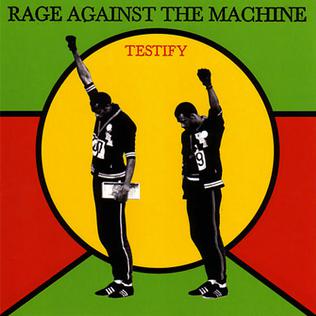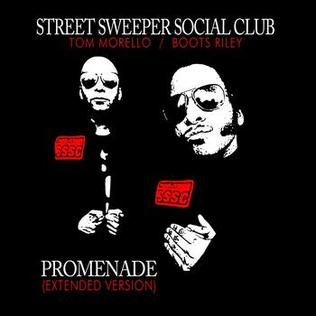
An effects unit, effects processor, or effects pedal is an electronic device that alters the sound of a musical instrument or other audio source through audio signal processing.

Edward John O'Brien is an English guitarist, songwriter and member of the rock band Radiohead. He releases solo music under the name EOB.

CV/gate is an analog method of controlling synthesizers, drum machines, and similar equipment with external sequencers. The control voltage typically controls pitch and the gate signal controls note on-off.

A pedalboard is a keyboard played with the feet that is usually used to produce the low-pitched bass line of a piece of music. A pedalboard has long, narrow lever-style keys laid out in the same semitone scalar pattern as a manual keyboard, with longer keys for C, D, E, F, G, A, and B, and shorter, raised keys for C♯, D♯, F♯, G♯ and A♯. Training in pedal technique is part of standard organ pedagogy in church music and art music.

Bass pedals are an electronic musical instrument with a foot-operated pedal keyboard with a range of one or more octaves. The earliest bass pedals from the 1970s consisted of a pedalboard and analog synthesizer tone generation circuitry packaged together as a unit. The bass pedals are plugged into a bass amplifier or PA system so that their sound can be heard. Since the 1990s, bass pedals are usually MIDI controllers, which have to be connected to a MIDI-compatible computer, electronic synthesizer keyboard, or synth module to produce musical tones. Some 2010s-era bass pedals have both an onboard synth module and a MIDI output.
Keyboard expression is the ability of a keyboard musical instrument to change tone or other qualities of the sound in response to velocity, pressure or other variations in how the performer depresses the keys of the musical keyboard. Expression types include:

Juan Alderete de la Peña is an American musician, best known as the longtime bassist of Racer X, the Mars Volta and Marilyn Manson.

"Mofo" is a song by Irish rock band U2. It is the third track on their 1997 album Pop, and was released as the album's final single on 8 December 1997. The song was partially written about lead vocalist Bono's mother, who died when he was 14 years old. Other songs which Bono wrote about his mother include "Lemon", "I Will Follow", "Iris " and "Tomorrow".

Pitch shifting is a sound recording technique in which the original pitch of a sound is raised or lowered. Effects units that raise or lower pitch by a pre-designated musical interval (transposition) are called pitch shifters.
"Know Your Enemy" is a song by American rock band Rage Against the Machine. It features Tool vocalist Maynard James Keenan on vocals during the bridge section, and Jane's Addiction drummer Stephen Perkins playing additional percussion. Allmusic describes the song as "immediately memorable" and "surprisingly straightforward" while music critic Joel McIver cited it as "a standout track" of the album.

"Calm Like a Bomb" is a song by American rock band Rage Against the Machine from their third album The Battle of Los Angeles. Like their song "Tire Me" from the 1996 album Evil Empire, “Calm Like a Bomb” never had a music video or was released on any media formats. It did, however, receive enough radio airplay to become an album favorite.

"Testify" is a song by American rock band Rage Against the Machine. It is the opening track from their third album The Battle of Los Angeles (1999), and was released as the third single from the album.

Brian Gibson is an American musician, artist, and video game developer based in Providence, Rhode Island. Gibson is best known as the bassist for the band Lightning Bolt. In the summer of 2015 he co-founded the game development company Drool. At Drool, he created the art and music for the video game Thumper and co-designed the game alongside Marc Flury. Thumper was released with critical acclaim in October 2016. He was previously a lead artist working at video game company Harmonix since 2001, but quit in the summer of 2015.

A guitar technician is a member of a music ensemble's road crew who maintains and sets up the musical equipment for one or more guitarists. Depending on the type and size of band, the guitar tech may be responsible for stringing, tuning, and adjusting electric guitars and acoustic guitars, and maintaining and setting up guitar amplifiers and other related electronic equipment such as effect pedals.

A guitar synthesizer is any one of a number of musical instrument systems that allow a guitarist to access synthesizer capabilities.
The Roland GR-500 is a guitar synthesizer. Manufactured by the Roland Corporation and FujiGen in 1977, it was one of the first guitar synthesizers.

"Promenade" is the second single by rap rock supergroup Street Sweeper Social Club from their debut self-titled album. The version that was released as a single differs from that on the album, the original version on the album is 2:31 in length whereas the extended version is 3:40 in length. The extended version features a guitar solo by Tom Morello, the extended version is also on The Ghetto Blaster EP, but is listed as the 'Guitar Fury remix'.

A bass chorus is an electronic effect used with the electric bass. It creates the same "shimmering" sound as a chorus effect for electric guitar chorus pedals, which recreates the sound of having multiple instruments doubling the same musical line. The difference is that bass chorus pedals are modified in various ways to suit the low pitch register of the electric bass. While several bass chorus pedal manufacturers have modified the chorus circuit so that it does not affect the lower register, others have designed the effect so that it can have an effect on even very low pitches.

The Klon Centaur is an overdrive pedal made by the American engineer Bill Finnegan between 1994 and 2008. Finnegan hoped to create a pedal that would recreate the harmonically rich distortion of a guitar amplifier at a high volume.
The 12 Step foot controller is a bass pedal-style programmable MIDI controller pedal keyboard made by Keith McMillen Instruments which was released in 2011. It has small, soft, rubbery keys that are played with the feet. As a MIDI controller, it does not make or output any musical sounds by itself; rather, it sends MIDI messages about which notes are played to an external synth module or computer music program running on a laptop or other computer. Each key on the 12 Step senses the velocity, aftertouch pressure, and the amount of tilt the player is applying with his feet. The messages from the player's foot presses can be sent via USB to a computer-based virtual instrument or to a synthesizer or other electronic or digital musical instrument.



















